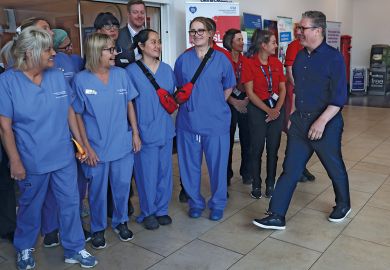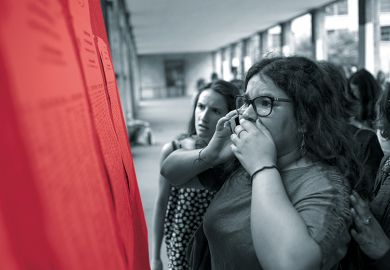Teacher shortages in England are once again in the news. In the autumn, we were warned of a looming problem, but we now seem to be very much in the crisis zone: the government has missed recruitment targets for four years, and certain secondary subjects are facing chronic staffing issues.
The recent National Audit Office report Training New Teachers is unequivocal in its warning to the government that the current state of play is not working, with Amyas Morse, head of the NAO, saying: “Until the Department [for Education] meets its targets and can show how its approach is improving trainee recruitment, quality and retention, we cannot conclude that the arrangements for training new teachers are value for money.”
So, what to do? Teacher supply is clearly critical, and it is important to remember that universities have an important role to play here, with 50 per cent of teacher training places currently allocated to university courses. Therefore, from the point of view of a university committed to educating future teachers, there appear to be three key issues that, if addressed, may improve the recruitment, quality and retention of those training to be teachers:
- Improving information and coordination as regards routes into teaching
- Dispelling the myth that university initial teacher training programmes are not school-based
- Ending the practice of penalising strong recruitment on to university initial teacher training programmes.
However, addressing these will demand joined-up thinking and a spirit of partnership working from the government, schools and universities alike. We have to work together to safeguard the future of teacher supply in this country.
Improving information and coordination as regards routes into teaching
The National College for Teaching and Leadership (NCTL) has increased the number of routes by which trainees can achieve qualified status: university-led undergraduate and postgraduate routes, and school-led routes Teach First, School Direct (salaried and fee) and school-centred initial teacher training.
However, potential applicants do not have good enough information to help them decide where to train, and they appear to be confused by the range of training routes available. Routes not only vary with respect to their perceived lead location, university or school, but also the qualification available – qualified teacher status alone or QTS with a degree or postgraduate academic qualification. The competition for places that the NCTL has established between providers and the swift implementation of these changes have exacerbated this confusion.
However, the deep relationships that universities have with their partnership schools and the shared commitment to recruiting and training the best possible teachers for the pupils in their classes is what will overcome with this. This is best exemplified by shared strategic approaches to recruitment with clear information on the routes available so that all those entering the profession are trained on their preferred route with the understanding that “one size doesn’t fit all” and one route isn’t a deficit model to another.
Dispelling the myth that university initial teacher training programmes are not school-based
The government is keen to emphasise school-led teacher training as a policy direction of travel, and it is fair to say that universities up and down the land would agree that teacher training has to happen in schools. What is not so widely appreciated is that a typical postgraduate university teacher training course will involve at least two-thirds of the time being spent in school, with a balance of 120 days’ school experience and 60 days of academically related input.
Our own university works actively in partnership with 800 primary schools and 400 secondary schools, without whom we would not be delivering teacher training at all. Such partnership working means we can also develop associated professional development courses with these schools and offer master’s programmes that support a culture of lifelong learning that allow teachers to develop thoughtful, reflective and scholarly approaches to their profession and career pathways through to leadership. Universities are delivering initial and continuing teacher training that is unequivocally school-based.
Ending the practice of penalising strong recruitment on to university initial teacher training programmes
The allocation model for recruitment to university-led courses starting in September 2016 has proved extremely challenging for two main reasons:
- The number allocated to university courses was cut by 25 per cent mid-recruitment cycle
- Once a subject or course has recruited to its national allocation (as set by the NCTL), it is closed with immediate effect.
The former makes strategic planning in terms of resource allocation and local supply of qualified teachers impossible, and it appears to make little financial sense as the NAO report indicates that university-led routes represent better value for money.
The second is far more damaging. Twice so far this year, we have had the unenviable task of communicating to applicants presenting for interview that their course has been closed. On both occasions, we received this information by email the night before, giving us no time to communicate with applicants before travelling – and some had spent considerable amounts of money getting to us. We have worked closely with the applicants to guide them on to other routes or institutions, but the fact remains that their preferred choice was denied them and their entry into the profession has been characterised by emotional upset, distress and the knowledge that this appears to be of little value or consideration to the NCTL.
Teacher shortages are growing, particularly in low socio-economic areas and at secondary level. As a nation, we are facing an unprecedented crisis that could leave a legacy for generations to come in terms of a poorly resourced and low-quality education system. Universities want to be part of training and supporting great teachers who love their work and who are committed to transforming the lives of young people across our nation. We want to continue to deepen our partnerships with schools and to work together with the government, through the NCTL, to continue to make this happen: at point of writing we don’t know whether we will be allowed to do so.
Maureen Glacklin is head of the School of Education, Theology and Leadership, and Claire Taylor is pro vice-chancellor (academic strategy) at St Mary’s University, Twickenham.
Register to continue
Why register?
- Registration is free and only takes a moment
- Once registered, you can read 3 articles a month
- Sign up for our newsletter
Subscribe
Or subscribe for unlimited access to:
- Unlimited access to news, views, insights & reviews
- Digital editions
- Digital access to THE’s university and college rankings analysis
Already registered or a current subscriber? Login







